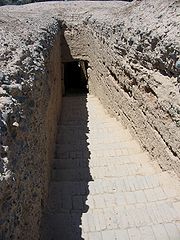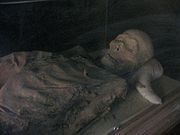
Astana Graves
Encyclopedia

Gaochang
Gaochang is the site of an ancient oasis city built on the northern rim of the inhospitable Taklamakan Desert in Xinjiang, China. A busy trading center, it was a stopping point for merchant traders traveling on the Silk Road...
, and 42km from Turpan, in Xinjiang
Xinjiang
Xinjiang is an autonomous region of the People's Republic of China. It is the largest Chinese administrative division and spans over 1.6 million km2...
, China
China
Chinese civilization may refer to:* China for more general discussion of the country.* Chinese culture* Greater China, the transnational community of ethnic Chinese.* History of China* Sinosphere, the area historically affected by Chinese culture...
. The tombs were used by the inhabitants of Gaochang, both commoners and locals, for about 600 years from 200
200
Year 200 was a leap year starting on Tuesday of the Julian calendar. At the time, it was known as the Year of the Consulship of Severus and Victorinus...
CE – 800
800
Year 800 was a leap year starting on Wednesday of the Julian calendar. It was around this time that the Anno Domini calendar era became the prevalent method in Europe for naming years, so from this time on, the years began being known as 800 and onwards.- Europe :* December 25 - Pope Leo III...
CE. The complex covers 10 square kilometres and contains over 1,000 tombs. Different plots for separate castes and families are marked by gravel dividers. Due to the arid environment many important artifacts have been well preserved at the tombs, including natural mummies.
A typical tomb is entered by a 10 metre sloping staircase. The tombs are not very large, usually only 2 metres high. Some tombs also have murals inside. The deceased were laid on a small raised platform in the back of the tomb, surrounded by possessions and even food. Their faces were covered by cloths
Textile
A textile or cloth is a flexible woven material consisting of a network of natural or artificial fibres often referred to as thread or yarn. Yarn is produced by spinning raw fibres of wool, flax, cotton, or other material to produce long strands...
, some of which have distinct Persian motifs. A small funeral brick was placed to next to each body, on which was written the person’s name and other biographical information. These bricks have been incredibly useful for historians to date the tombs’ finds.
There are also various Tang Dynasty
Tang Dynasty
The Tang Dynasty was an imperial dynasty of China preceded by the Sui Dynasty and followed by the Five Dynasties and Ten Kingdoms Period. It was founded by the Li family, who seized power during the decline and collapse of the Sui Empire...
figurines and Chinese silk paintings in the Graves. A new pavilion has been built outside the old graveyard; the centrepiece is a large statue of Fuxi and Nüwa
Nüwa
Nüwa is a goddess in ancient Chinese mythology best known for creating mankind and repairing the wall of heaven.-Primary sources:...
based on the silk banners found on the inner ceilings of the tombs.



